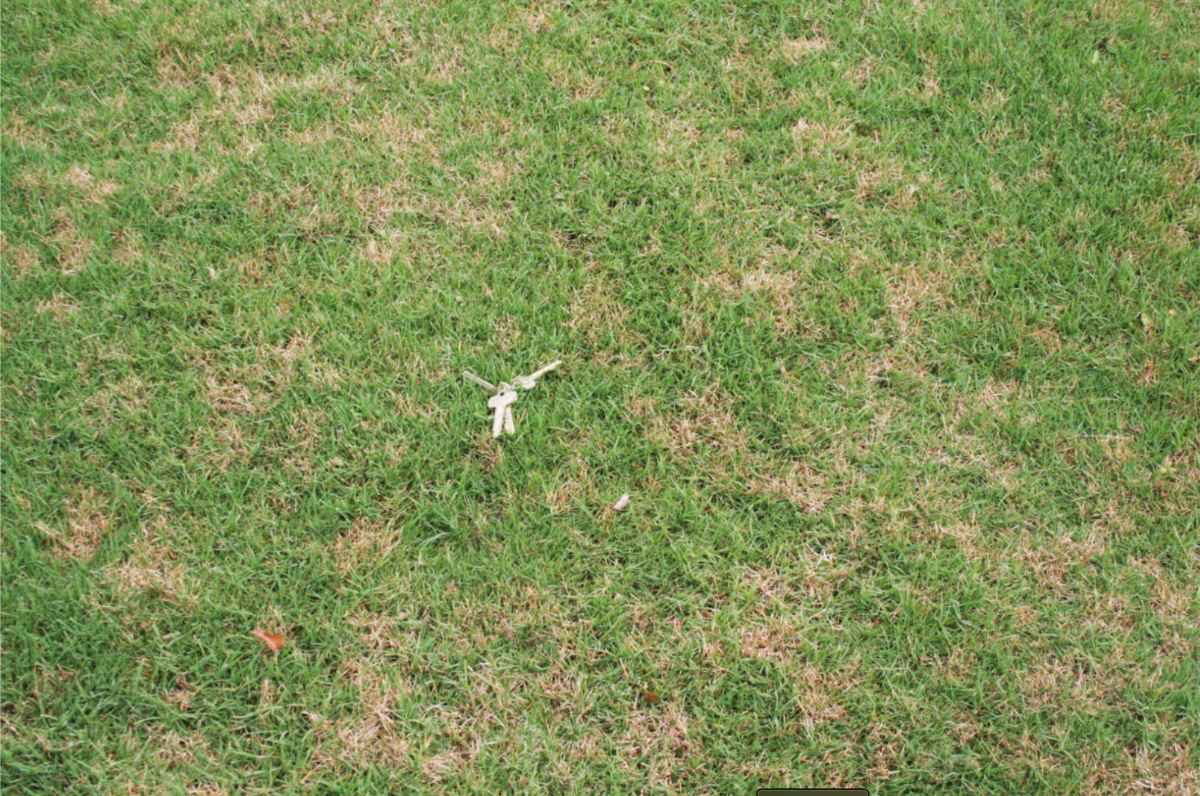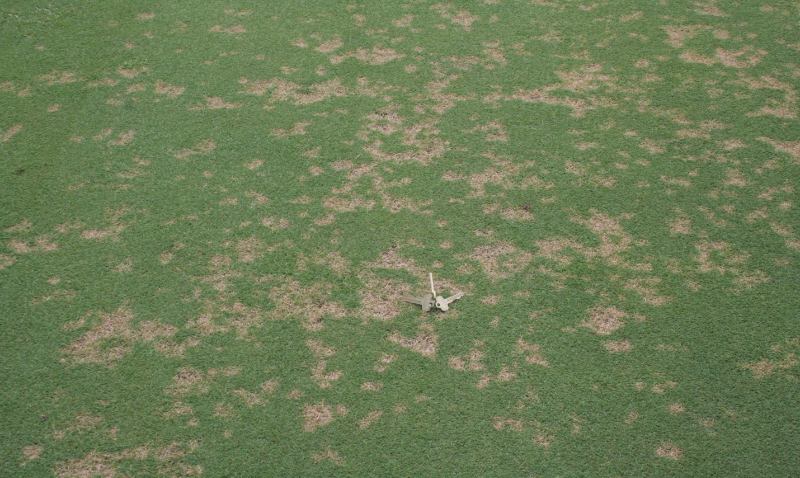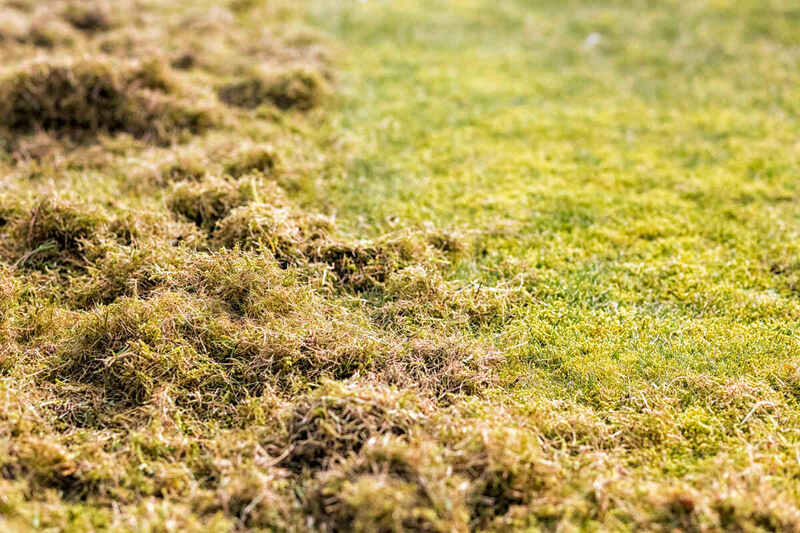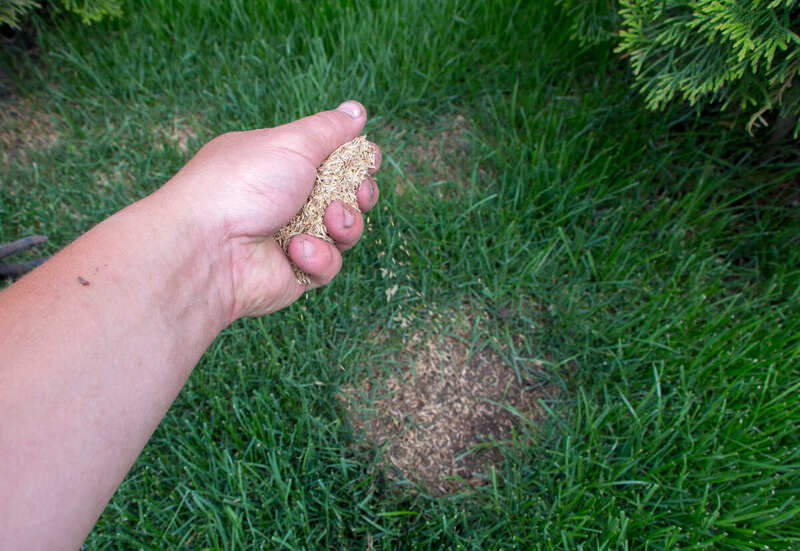
Those silver-dollar-like tan spots scattered on your lawn are not only unsightly — they’re a sign that dollar spot disease is taking hold.
A common lawn disease that tests homeowners’ patience, dollar spot spreads through threads of white mycelium, turning small patches into large, brown areas that can take over the lawn. According to our expert, the good news is it’s entirely manageable if you know how to get rid of dollar spot fungi with proper lawn care practices and fungicides.
Apply Nitrogen Fertilizer
Proper nutrition is critical for disease resistance. As Alfredo Martinez-Espinoza, professor and Extension specialist at the University of Georgia’s Department of Plant Pathology, puts it, “Sound soil nutrition and appropriate soil fertility [especially proper nitrogen and potassium amounts] are the foundations of dollar spot prevention.”
To get your nitrogen levels right:
- Learn your grass’s nitrogen requirements (they differ by turf type).
- Watch for signs of nitrogen deficiency (yellowing in older, lower leaves).
- Test the soil (also check potassium and phosphorus levels, essential for disease resistance).
Mainly a spring and fall disease, dollar spot thrives while temperatures stay between 60 F and 85 F, so if infested, your lawn will first show signs in spring to early summer, depending on where you live. There’s a higher risk of infestation when heavy dew covers the lawn in the morning.
To prevent nitrogen deficiency at the most critical time, schedule a fertilizer application at the beginning of the growing season:
- Early to mid-spring for cool-season grasses
- Late spring or early summer for warm-season grasses.
This strategic feeding promotes vigorous foliar growth during the peak infestation period, essentially helping your turf outgrow the disease.
| Protect your lawn from dollar spot disease with professional lawn treatments. Our pros treat lawns for an average of $106 per visit and keep your turf disease-free year-round. |
Nitrogen applications can also be used as part of the dollar spot fungus treatment, but be careful not to overdo it. According to Martinez-Espinoza, over-fertilization can also trigger fungal diseases and lead to Pythium blight, Rhizoctonia large patch, or brown patch outbreaks.
See Related:
- 6 Different Nitrogen Sources for the Lawn
- 9 Reasons Why Soil Testing Is Important for the Lawn
- How to Read a Soil Test Report
Fix Your Watering Schedule

Dry soil is as dangerous as prolonged leaf wetness. As Martinez-Espinoza explains, drought stress increases the risk of fungal infection, especially when you combine “dry soil [and] humidity on the canopy,” which pairs weakened grass with thriving dollar spot fungus.
To limit dollar spot infestations and keep the grass strong, follow these 3 rules:
- Water deeply and less often to promote deep roots and minimize leaf wetness.
- Water the lawn early in the morning, before sunrise.
- Avoid evening watering to limit leaf wetness during the nighttime hours.
See Related:
Raise Your Mowing Height

Dollar spot fungi are most aggressive in golf courses where excessive low-mowing stresses the grass. Use the reverse strategy to protect your lawn: raise the mowing height.
Why does it work? With longer leaves available for photosynthesis, tall turfgrass has more energy to fight off dollar spot, and fungi need more time to reach the plant’s crown. The crown is the turfgrass’s growth point, so the plant dies if it’s severely damaged.
A good rule of thumb is to keep your turfgrass 2 to 3 inches tall, but the recommended mowing height varies with the type of turfgrass. Check the best height for your turf type in LawnStarter’s guide: How to Mow a Lawn the Right Way.
I also follow these simple mowing rules:
- Don’t mow wet grass.
- Don’t cut more than 1/3 of the blade (the one-third rule).
- Keep the mower blades sharp.
- Mow the infected areas last and dispose of the grass clippings.
- Disinfect the mower, shoes, and clothing after walking on diseased grass.
| Give your lawn a professional cut to keep it strong and healthy. Our pros charge an average of $48 per visit to mow a small lawn and leave behind a neat green carpet. |
See Related:
Apply Fungicide Treatment
Dollar spot fungi are well-known for developing resistance to traditional fungicides, so the products you buy from the garden store may not work.
According to Martinez-Espinoza, homeowners have limited access to effective fungicides for managing dollar spot and should rely on proper lawn care practices and selecting disease-resistant varieties as their primary strategy to control this disease.

The good news is that dollar spot fungicide resistance is not equally developed across the country or across turfgrass species, so you can still try to treat the lawn with home-use dollar spot fungicides if you:
- Follow the application instructions carefully.
- Monitor the results according to the timeline indicated on the package to ensure it works
- Change the dollar spot fungicide periodically to prevent the fungi from developing resistance.
Most often, fungicides are applied as a curative method when signs of dollar spot are visible on the lawn, but preventive application can also help — spreading a dollar spot fungicide in the spring, before air temperatures rise above 60 F, can limit outbreaks later in the season.
How do you get rid of dollar spot fungus organically? Homeowners who want to avoid harsh chemicals can use biofungicides, such as Rhapsody and Regalia. These products work best as preventive treatments, so make sure to apply them before the onset of dollar spot or as soon as you see signs of infection.
Other organic options include natural fungicides, such as those made with neem oil.
However, in severe infestations that spread across large areas in your lawn, it’s usually best to hire a lawn treatment expert — pros have access to more potent fungicides not available for DIY applications.
See Related: 8 Best Lawn Fungicides [Reviews]
Remove Thatch

Thick thatch shelters dollar spot fungi during winter and spreads them to healthy grass in the spring.
This layer of dead and living grass that forms above the soil can compromise soil drainage, preventing water and nutrients from reaching the grass roots. Your solution: Remove thatch thicker than 0.5 inches in fall or spring, when the grass is actively growing.
- The most popular methods are dethatching and vertical mowing.
- Martinez-Espinoza also recommends topdressing the lawn, which involves spreading a thin layer of topsoil either after dethatching or aerating, or as a standalone treatment.
Added topsoil brings in microbes that speed up decomposition and loosen the thatch. Choose a topsoil that fits your lawn’s soil type — most commercial topsoils are a mixture of sand, clay and decomposed organic matter.
See Related:
Improve Soil Drainage
Dense, compacted soil prevents the plant from accessing water, nutrients, and oxygen. It compromises growth, but also slows down recovery from fungal diseases, such as dollar spot.
Try to stick a screwdriver into moist soil in your lawn. If you struggle, the soil is compacted. To fix compacted soil:
- Core aerate the lawn.
- Topdress the lawn with a 1/4 to 1/2 inch layer of compost.
Overseed With Resistant Grass Varieties

Tall fescue, perennial ryegrass, and fine fescues are typically known to better withstand this disease, while Kentucky bluegrass, creeping bentgrass, Bermudagrass, Zoysia, and seashore paspalum are more susceptible to dollar spot disease.
However, for all species, dollar spot resistance differs between cultivars, so focus on finding specific varieties created to resist this disease. A few examples are:
- Kentucky bluegrass ‘Midnight’
- Perennial ryegrass ‘Silver Dollar’
- Bermudagrass ‘Mirage 2’
- Hard fescue ‘Gladiator’
- Zoysia ‘Compadre’
The best approach is to contact your local County Extension Office and inquire about the optimal mix of cultivars for growing a dollar spot-resistant lawn. Matching the species and cultivar to your local climate makes the grass more resilient and easier to care for.
FAQ
Treating dollar spot disease completely takes at least 1 to 2 months from the time you apply fungicides and depends on numerous factors, including infection severity, soil quality, and proper cultural practices.
To identify dollar spot in your lawn, look for:
• Small, round, silver-dollar-like bleached spots, 1 to 5 inches wide
• Tan hourglass-like leaf lesions with a reddish-brown edge
• Larger patches of tan grass
• White, cobweb-like mycelium on the grass on dewy mornings.
When to Call a Professional
If you’ve tried lawn care practices and traditional fungicides for more than a month with no results, and now the damage covers more than 25% of the lawn, it’s time to call in the cavalry. Find a lawn treatment pro near you with LawnStarter and start healing your lawn today.
Sources:
- Alfredo Martinez-Espinoza, professor in the Department of Plant Pathology and Extension specialist at the University of Georgia, Griffin, GA. Personal interview.
- “Cultural Practices to Minimize Dollar Spot on Creeping Bentgrass.” By plant science specialists Alex Ellram, Brian Horgan, and Brent Hulke. Golf Course Management, 2007.
- “Dollar Spot Already Returning in 2025: Be Prepared.” By Geunhwa Jung, professor of turfgrass pathology. University of Massachusetts.
- “Dollar Spot Of Turfgrasses In Georgia: Identification and Control.” By plant pathology experts Alfredo Martinez-Espinoza, Elizabeth Little, Kimberly Toal, and Brian Vermeer. University of Georgia.
- “Dollar Spot of Warm-Season Turfgrasses.” By Alan Henn, Extension professor, Missouri State University Extension.
- “Turfgrass Selection Bluegrasses.” By Tom Samples, professor, and John Sorochan, associate professor of plant sciences. University of Tennessee.
Main Image Credit: Alfredo Martinez-Espinoza / University of Georgia